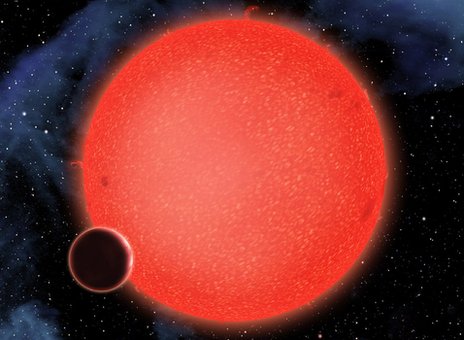Super Earth-Sized Waterworld Confirmed By Hubble Telescope
Discovered back in 2009, exoplanet GJ 1214b has been the focus of interest from the start. One of the first planets discovered to have an atmosphere, there’s been a lot of guessing as to exactly what kind it actually has. In 2010, tests showed that the atmosphere was primarily composed of water, and now infrared spectra taken by the Hubble Space Telescope have confirmed that it is in fact a waterworld and a planet unlike any other that has been previously discovered.
Like Earth, GJ 1214b has a plentiful supply of water, but it’s unlike Earth in about every other respect. GJ 1214b comes in at about 2.7 times the size of Earth in diameter and about 7 times the weight. GJ 1214b is also a lot closer to its sun than we are to ours; it sits a mere 1.24 million miles out, lapping the star every 38 hours. The Earth, on the other hand, hangs out at a distance of approximately 93,000,000 miles from our sun, completing one rotation every 8,765 hours or so (1 year). As such, GJ 1214b is a bit hotter than Earth with a temperature that’s probably around 446 degrees Fahrenheit (230 Celsius).
Up until now, it was clear that GJ 1214b’s atmosphere was clouded up with something but no one could be clear if it was steam or some other sort of haze. Now, after making a convenient pass in front of its own sun at just the right time, GJ 1214b was in a great position to be scanned by the Hubble’s Wide Field Camera 3, which picked up details about the planet’s atmosphere and confirmed it was composed primarily of steam.
By doing some calculations with all the known variables, scientists were able to calculate GJ 1214b’s overall density, 2 grams per cubic centimeter, which suggests that it has far more water and far less rock than Earth. This fact, in conjunction with the planet’s high temperature, means that it’s probably home to all kinds of phenomena we never see here on our little blue planet, phenomena like “hot ice” and “superfluid water.”
Fortunately, GJ 1214b is pretty close to Earth, in astronomical terms anyways. It’s only about 40 light-years away, and while that means you aren’t likely to see any of the planet’s hot ice in person — not like you’d survive anyways — the James Webb Space Telescope should be able to get a good look after its launch later this decade. If you want to know the gritty details, you can read a paper on the planet here. And if you don’t feel like diving into that, let me put it this way: It’s probably a pretty interesting place, but not even a gilled Kevin Costner could survive this waterworld firsthand.
(via Universe Today)
Have a tip we should know? [email protected]
